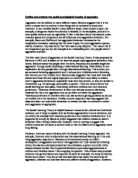Outline and evaluate two social psychological theories of aggression
Aggression can be defined in many different ways. Bandura suggests that it is the intent to cause harm to another human being who is motivated to avoid such treatment. It can manifest itself in many different ways; these include in sport, for example, a dangerous tackle from behind in football, in the workplace, school or in other public sections such as nightclubs. In fact it has been found that alcohol, noise, crowded spaces and temperature are all influences over aggressive behaviour. For example, Baron and Bell found that aggressive behaviour increased as the temperature increased, meaning that the hotter it gets, the more aggressive a person will be. However, they also found that there was a drop off point. This means that if the temperature got too hot, for example at an unbearable point, then people weren’t aggressive anymore.
The first main theory of aggression is the Social Learning Theory. It was proposed by Bandura in 1961, and is based on the idea that people copy aggressive behaviour from others. Bandura stated that people learn the form, frequency and suitable targets for aggression through social modelling or observational learning. Disinhibition is one explanation for why people learn through observational learning. This is when you see someone behaving aggressively and it reduces your inhibitions about behaving like that and you then imitate them. Bandura also suggested that those with low self-esteem and those who are highly dependent on others were more likely to imitate other’s aggressive behaviours, especially those who they admire, or who are similar to themselves, e.g. the same age, personality or gender. There are various forms that social learning can take place, these being vicarious reinforcement and vicarious punishment. Vicarious reinforcement is when you witness someone else being rewarded for his or her aggression and so you want to imitate the aggression. Vicarious punishment is therefore when you see someone getting punished so you do not imitate his or her behaviour. Finally, context-dependent learning suggests that observers learn not only which behaviour to imitate, but also the contexts in which such aggression is appropriate.






